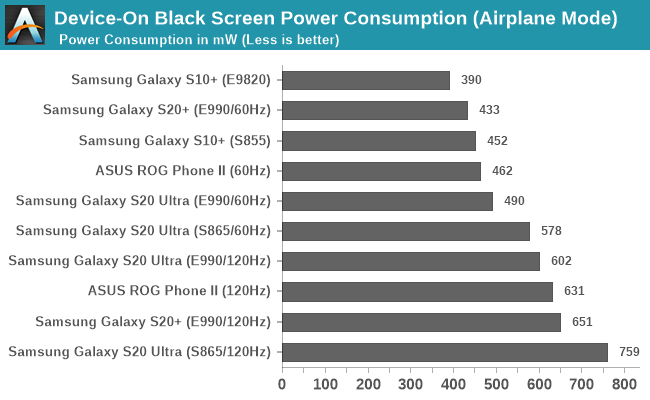The Samsung Galaxy S20+, S20 Ultra Exynos & Snapdragon Review: Megalomania Devices
by Andrei Frumusanu on April 3, 2020 9:30 AM ESTBattery Life: Good (60Hz) to Average (120Hz)
Last week we had published our initial battery life report on the S20 series, with some interesting findings. First of all, what needs to be mentioned again is that the new 120Hz display modes on the phones come with a quite large battery life impact. The behavior is exhibited on all our S20 models at hand and I think it’s likely due to the panel itself or the DDIC. Samsung had included various display refresh modes varying from 48, 60, 96 and 120Hz, however we have yet to find evidence of any mechanism that actively switches between the various modes.

As such, even on a black static screen, running at 120Hz comes with a quite steep power penalty that’s always present whenever the display is on, costing around 160mW of power.
I had noted that I found our variant of the Snapdragon 865 Galaxy S20 Ultra to have worse idle power than our Exynos phone version. Initially I had attributed this to possibly the SoC or even the nature of the external X55 modem, but since then I’ve also received an LG V60 and that device’s idle power is perfectly normal. The only other thing that differentiates our S20 Ultra here is the fact that it has the extra mmWave antennas and RF systems. It would be interesting to see if non-mmWave variants of the Snapdragon S20 Ultra behave any differently (Tip at our Chinese or Korean readers).
I also had made mention that the “Performance” mode of the Exynos S20 phones seemingly behaved quite overzealously in terms of its scheduling settings, and there was a quite drastic increase in power draw for what was not nearly an as drastic increase in performance. I’ve rerun the battery tests in the “Optimized” settings which doesn’t have the “Increased system speed” option enabled, and I’ve confirmed my suspicion as the battery life figures did improve by some notable amounts. I’ve also tested the Snapdragon in the “Optimized” setting and the runtimes only differed by 2% - for users having the Snapdragon versions it’s thus safe to simply leave that enabled.

In our web test, the new S20 series end up right about where you’d expect them to. The Snapdragon 865 Galaxy S20 Ultra at 60Hz fares the best amongst the tested models, and now represents Samsung’s longest lasting flagship device. Slightly behind it we find the Exynos S20 Ultra at 60Hz. The difference between the two phones here isn’t very big in this test, and I attribute this to the higher constant idle power draw of the Snapdragon phone which counteracts the much higher compute efficiency of the SoC. The Eyxnos S20+ ends up slightly behind the S10+ phones, but still lasts a good 12.65h in this test.
Once we turn on the 120Hz display modes, the battery life results on all the phones drops quite notably. The Snapdragon S20 Ultra goes from 14h to 11.3h, a 20% drop. The same applies to the Exynos S20 Ultra, with a 20% drop, but for some reason the S20+ sees a larger drop of 25%. In the systems performance section I did mention that there’s some software configuration differences between the Exynos S20 Ultra and S20+, maybe some of that plays part here in the results.

Overall, the conclusion on battery life isn’t quite as black & white as we thought it would be. The key point is to stay away from the seemingly broken Performance mode on the Exynos chipset and you’ll have roughly similar battery life results between the two SoC variants of the S20. Naturally, that’s only being achieved by the fact that the Exynos does showcase worse performance, saving energy by using the more efficient lower performance states more.
What’s valid for all variants of the phones is that the 120Hz display mode is quite the power hog. Samsung probably has the opportunity to improve this by introducing a better managed variable refresh rate mode that actually changes between the different refresh rates based on content, something that seemingly isn’t happening right now. Also switching to lower refresh rates when showcasing static content would be a huge power saver, but I’m not sure if Samsung would be able to actually deploy such a mechanism.










137 Comments
View All Comments
Suraj tiwary - Sunday, April 12, 2020 - link
When will u start testing with Spec2017? Even arm despite being a marketer of its SOC uses both (spec2017 shows less scores) & U despite being a reviewer are too late.xGeoThumbs - Thursday, April 16, 2020 - link
I always come to these reviews for the photography comparison. They are done really well. Really surprised by the oversharpening on the Snapdragon model compared to the Exynos. The Pixel 4 would also do much better if you find the time to use the Night Sight feature during daytime photography. It improves white balance and detail rendition. Keep it up!damianrobertjones - Thursday, April 23, 2020 - link
The Amazon reviews, for this phone aren't the best in the world.Junphy - Thursday, May 7, 2020 - link
Why not add Mediatek Dimensity 1000 for a comparison ?hemingway9000 - Saturday, June 6, 2020 - link
Hi,could you guys somehow please investigate this? https://www.youtube.com/watch?v=h4F0L-soM1I
It seems that this "Game Optimizer Service" seems to be behind the problems caused in the s20 performance. It would be great if you could do a deep dive into it. Thank you.
Archer_Legend - Thursday, August 13, 2020 - link
Usaul amazing rewiew, i read it again after 6 months and it is done very wellspicekitkat - Monday, October 5, 2020 - link
Great article, when a phone comes out I'm really interested in the sound of that phone, hope it will have this sound: https://chakushinon123.com/samsung-s20-ultra/